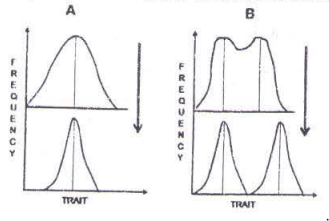 Multiple Choice Questions
Multiple Choice QuestionsTwo kinds of natural selection (A and B) acting on a trait are shown in the figure below. In each, the top graph shows the trait frequency before and the bottom graph frequency after the action of natural selection.

The kind of natural selection in A and B are
A - Directional; B- Diruptive
A - Neutral; B - Disruptive
A - Stabilizing; B - Disruptive
A - Disruptive; B - Stabilizing
In a random sample of 400 individuals from a population with alleles of a trait in Hardy-Weinberg equilibrium, 36 individuals are homozygous for allele a. How many individuals in the sample are expected to carry at least one allele A?
36
168
364
196
C.
364
There are 364 individuals in the sample who are expected to carry at least one allele A.
Individual A performs to another individual a behavioural act which has a fitness consequence. Match the behavioural acts (a to e) with the correct fitness consequence ((i) to (iv)).
| Behavioural act | Fitness consequence to A |
| Cooperation (a) | Gains direct fitness but after delay (i) |
| Adaptive altruism (b) | Loses inclusive fitness (ii) |
| Spite (c) | Gain indirect fitness (iii) |
| Deceit and manipulation (d) | Gains direct fitness but immediately (iv) |
| Reciprocity (e) |
a - (iv); b - (iii); c - (ii); d - (ii); e - (i)
a - (i); b - (ii); c - (ii); d - (iii); e - (iv)
a - (i); b - (iii); c - (ii); d - (ii); e - (iv)
a - (ii); b - (ii); c - (iii); d - (i); e - (iv)
Assume that individual A wants to do an altruistic act to individual B and that the benefit and cost of doing this act are, in 'fitness' units, 40 and 12, respectively. According to Hamilton's Rule, A should perform the altruistic act only if B is his
nephew
niece
grandson or granddaughter
daughter or son
Which of the following is NOT a benefit for the female adopting polyandry?
Greater probability of getting all her eggs fertilized.
Ability to receive more resources from the males.
Ability to produce more offspring than normal.
Improved chances of genetic compatibility with her own DNA.
Complete the following hypothetical life of a species to calculate the net reproductive rate R0:
| Age class (x) | Number alive (nx) | Number of dying (dx) | Age-specific survivorship | Age-specific Fertility | lxmx |
| 0-1 | 1000 | 0 | |||
| 1-2 | 800 | 0 | |||
| 2-3 | 200 | 0.5 | |||
| 3-4 | 300 | 100 | 1.0 | ||
| 4-5 | 200 | 1.0 |
The calculated R0 will be:
0.75
1.00
0.65
1.15
In life history evolution there is generally a trade-off between the size and number of offspring produced. Some conditions are listed below:
A. Scarcity of food during the early stages of life.
B. Provision of parental care.
C. High mortality during early stages of life.
D. Predator's preference for large sized prey.
What are the above two conditions that would favour the production of a small number of large-sized offspring?
B and C
B and D
A and B
A and C
The wings of insects and the wings of bats represent a case of
divergent evolution.
convergent evolution
parallel evolution
neutral evolution
Which species concept utilizes morphological and molecular characters to distinguish between species?
Evolutionary
Ecological
Biological
Phylogenetic
Worker bees, instead of themselves reproducing, help the queen reproduce. This behaviour is explained as an example of
kin selection
group selection
sexual selection
natural selection
